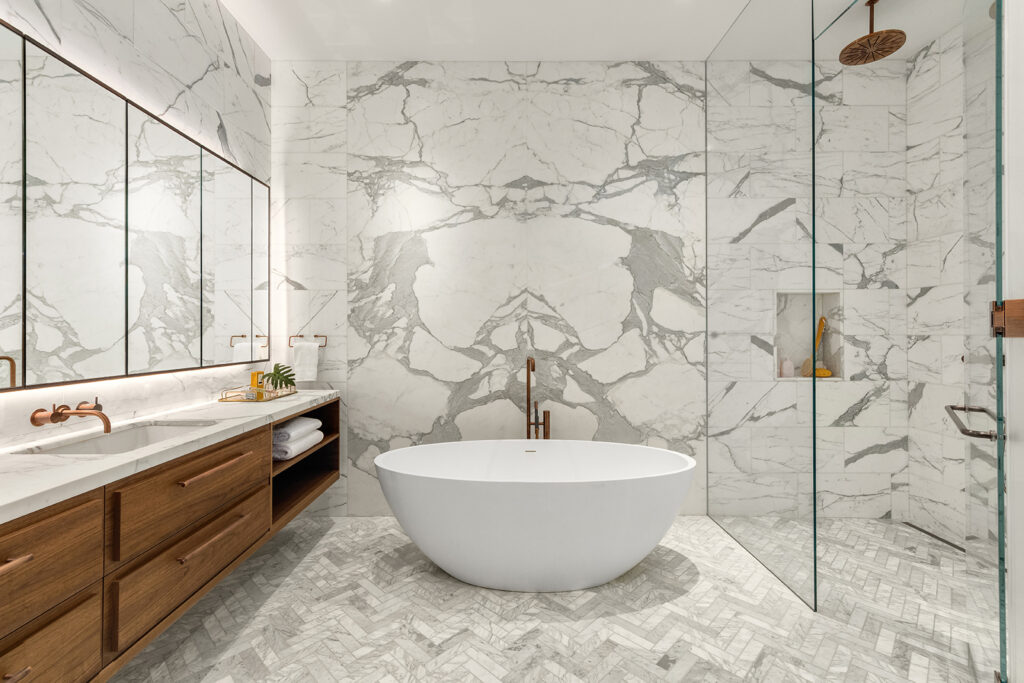
Bathroom Privacy Guide – Windows, Ideas & More in 2025
In home design, bathroom privacy often gets overlooked in favor of more glamorous elements like tile choices or statement tubs.
It’s never easy finding the right bathtub for your home or the right material, so why not choose the bathtub with no drawbacks? Copper tubs are remarkably durable, have excellent heat retention, come in a wide variety of sizes and styles and will grow even more vibrant with age. So if you are in the market for a new bathtub, let us discuss why a copper tub is a good fit for you.
A copper tub is a bathtub that is constructed from copper. Copper earns the benefit of being a highly durable metal but still is malleable enough to be molded into a variety of different shapes. This is important since other material can easily crack during the molding process and copper can easily withstand this process, producing a highly durable bathtub.
While specific statistics on the popularity of copper tubs can be challenging to find due to their niche market, I can provide some general insights and trends that might be useful:
These trends and data points reflect the rising interest and popularity of copper tubs in the luxury and eco-conscious markets. While exact statistics on copper tub ownership might not be readily available, these insights underline the material’s growing appeal.
Crafting a copper tub is a meticulous process that combines traditional craftsmanship with modern techniques, resulting in a durable and beautiful centerpiece for any bathroom. This step-by-step guide outlines the detailed process from selecting high-quality copper sheets to the final installation of the finished product.
The process begins with selecting high-quality copper sheets. The copper used is usually of a specific grade that ensures durability, malleability, and resistance to corrosion. The thickness of the copper sheets is chosen based on the desired strength and aesthetic of the final tub.
The copper sheets are measured and cut to the required size. These sheets will form the base, sides, and other components of the tub. Precision in cutting is crucial to ensure that all parts fit together seamlessly.
The copper sheets are then shaped into the tub’s form. This is done using a combination of hand-hammering techniques and mechanical tools. The sides of the tub are often shaped by bending the copper sheets over a mold or form to achieve the desired curves and contours.
Once the individual parts are shaped, they are assembled. The seams where the copper sheets meet are usually soldered or welded together. This step requires skill to ensure that the joints are strong and leak-proof.
Many copper tubs feature a hand-hammered finish, which is achieved by manually hammering the surface of the tub. This not only adds to the tub’s aesthetic appeal but also strengthens the copper by compressing the metal. This process is labor-intensive and requires a high level of craftsmanship.
After the tub is assembled, it is polished to achieve the desired finish. This could range from a high-gloss, mirror-like finish to a more rustic, matte appearance. Some copper tubs are treated to accelerate the patina process, giving them an aged look right from the start.
If a patina finish is desired, the copper tub is treated with various chemicals or left to oxidize naturally over time. The patina process gives the tub a unique, antique look with rich, varying hues.
The finished tub undergoes a thorough quality inspection. This includes checking the structural integrity, ensuring the seams are properly sealed, and verifying that the finish meets the desired specifications.
Once the tub passes inspection, it is carefully packaged to prevent any damage during transportation. The tub is then shipped to the retailer or directly to the customer.
Upon arrival, the copper tub is installed in the bathroom. Due to its weight and value, professional installation is often recommended to ensure the tub is properly supported and connected.
Copper tubs come in a wide variety of shapes and sizes to fit just about any bathroom. Each style has their pros and cons, so it’s best to understand which is the right fit for you before purchasing.
Copper tubs have become a popular choice for homeowners seeking a luxurious and durable addition to their bathrooms. Renowned for their striking aesthetic and practical benefits, these tubs offer a unique blend of beauty and functionality. However, like any investment, copper tubs come with their own set of advantages and disadvantages. In this section, we’ll explore the pros and cons of copper tubs, helping you make an informed decision about whether this timeless material is the right fit for your home.
| Pros | Cons |
|---|---|
| Durability: Incredibly durable, resists dents and scratches, and can last a lifetime. | Price Point: One of the most expensive bathtub materials on the market. |
| Mold-Resistant: Naturally resistant to mold and mildew, promoting a healthier environment. | Maintenance: Requires more care and special cleaning to avoid damage. |
| Antibacterial: Naturally reduces bacteria build-up. | Weight: Can be quite heavy, possibly requiring additional structural support. |
| Eco-Friendly: Made from recyclable material, making it an environmentally friendly choice. | Patina: While appealing to some, the changing color may not be desirable to others. |
| Heat Retention: Keeps bathwater warmer for longer periods, enhancing comfort. | |
| Long Lifespan: With proper care, it can last for generations. | |
| Aesthetic Appeal: Offers a unique, vibrant look that enhances bathroom design. |
Copper bathtubs enjoy many of the positives that acrylic bathtubs do. They are both flexible materials, able to be constructed in a wide variety of shapes and sizes. They both are also durable and have good heat retention although copper is much more durable and has better heat retention than acrylic. In almost every way, copper bathtubs are much better than acrylic, providing better durability, heat retention and aesthetic appeal. Acrylic however, is much more affordable, in addition to being a lighter weight material, allowing it to be much more versatile than copper as a result.
Outwardly, cast iron enjoys similar benefits to copper as it is a very durable material with excellent heat retention, similar to copper. Cast iron is much more affordable as well, costing about half the price of copper. This is where the similarities end, with cast iron being a material that is vulnerable to heavy impacts. It is also one of the heaviest materials on the market, requiring floor reinforcement to support. On the other end, abrasive cleaners can be used on cast iron where they cannot be used on a copper tub.
As discussed previously, copper bathtubs tend to be the most expensive bathtubs on the market. For all the benefits listed previously, a high quality copper bathtub starts around $2500-3,000 and easily can climb to $35,000 depending on the size, features and style of the tub itself. The $2,500 price range describes the small size of copper tub, where $5,000-7,000 is typical for a medium sized tub. Lastly, for $7500-10,000+ is the large size of copper tubs.
Copper tubs are available in various sizes to accommodate different bathroom layouts and preferences. The average size of a copper tub typically ranges from 60 to 70 inches in length. The sizes listed below represent common options, but custom sizes are also available to meet specific needs.
Custom sizes can be ordered for those who desire a tub that perfectly fits their space or specific design preferences.
Copper tubs offer more than just aesthetic appeal; they provide a range of health benefits that enhance your bathing experience. From natural antibacterial properties to superior heat retention, these features make copper tubs a smart choice for a healthier and more relaxing bath
2. Heat Retention:
Copper tubs constructed from pure copper are completely safe. Lower quality copper tubs may contain unsafe levels of mercury or lead, which is unsafe for bathing, so you should check your tubs composition to ensure it does not contain harmful elements.
While they are quite expensive, copper tubs are some of the best on the market. Providing health benefits as well as containing the benefits of all other materials on the market, copper bathtubs are a great choice, so consider one for your home today.

Eric is the founder and president of Badeloft USA. He has been the president of Badeloft’s US division for over ten years and oversees all marketing and branding aspects of Badeloftusa.com.
His expertise lies in small business development, sales, and home and bathroom industry trends and information.
Contact us with any business related inquiries.

Free material samples and tub templates

In home design, bathroom privacy often gets overlooked in favor of more glamorous elements like tile choices or statement tubs.

A well-designed bathroom is more than just a functional space—it’s a sanctuary. In today’s fast-paced world, luxury bathroom remodels have

A recent study by Badeloft USA identified the most underrated cities for real estate investments in the US by analyzing safety, affordability,

Toilets may seem like a one-size-fits-all fixture, but they come in various sizes and configurations to suit different spaces and
Fill out the form below to request a free material sample
"*" indicates required fields
"*" indicates required fields
"*" indicates required fields